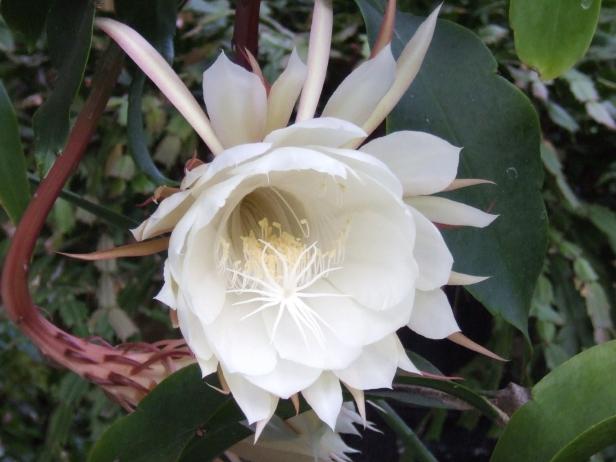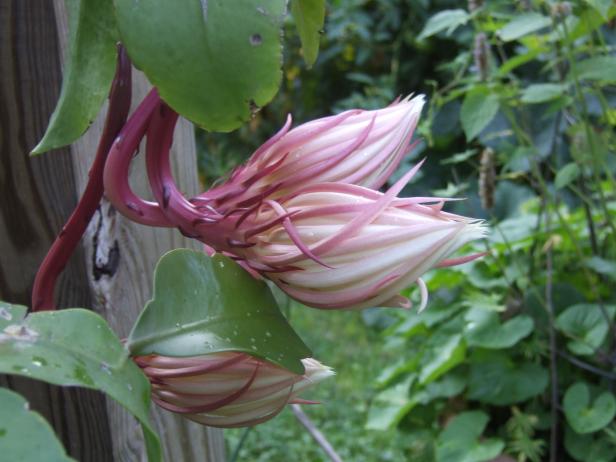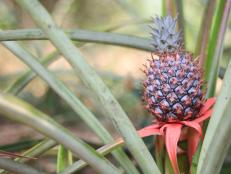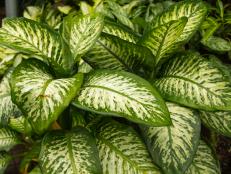How to Make Night-Blooming Cereus Bloom
Meet the original pajama party plant — and learn how to bring on the blooms.

Julie Martens Forney
Also known as queen of the night, night blooming cereus opens blooms at night.
Want some real flower power? Grow night-blooming cereus. This beauty opens its flowers after dark — and they only last for the night. It’s a plant that calls for an impromptu party, the kind where neighbors and friends pop in for a peek with sleepy kids in tow.
Also known as Epiphyllum oxpetalum, this unusual plant is a type of orchid cactus that’s native to a rain forest setting, where it grows perched high among the trees. The large, white flowers (9 inches across) release a rich, floral fragrance that can perfume an entire garden. Bats are the native pollinators of night-blooming cereus, visiting flowers after midnight when they open the fullest.
Night-blooming cereus isn’t difficult to grow. It’s a classic pass-along plant, and it’s not unusual to find one that’s been carefully handed down through generations via easy-to-root cuttings.
Growing Basics
In all but the warmest regions, grow night-blooming cereus as a houseplant. Give it a spot outdoors for summer with filtered light or morning sun. Protect plants from hot afternoon sun, which can burn leaves. Plants produce lots of new growth in spring and summer. Water regularly, but allow the soil to dry out between waterings. Tuck plants into soil that drains well, such as cactus mix or soilless container mix. Fertilize plants every 10 to 14 days with water-soluble plant food (10-10-10 works fine).

Julie Martens Forney
Night blooming cereus forms flower buds on older leaves. Giving plants bright light is a key to getting flower buds to form.
A night-blooming cereus produces pencil-like stems and flattened stems, which most people refer to as leaves. Those leaves that have been around at least two active growing seasons are the ones that develop flower buds, which form in the scalloped indentations along the leaf edge. Plants typically blossom in summer and/or fall. Four things help trigger flower bud formation:
- bright light (but not too bright, as noted above)
- regular fertilizer after moving plants outside for summer
- keeping plants slightly rootbound
- proper winter treatment (see below)

Julie Martens Forney
The flower buds on a night blooming cereus enlarge and become puffy the night they will open. Bracts surrounding the bud turn pinkish and curl like wispy hairs.
After flower buds appear, they slowly enlarge. A few days before opening, the flower stem bends, so the blossom is parallel to the ground. The day of blooming, the flower buds swell, petals are clearly visible, and outer bracts appear plump and wavy.
Night-blooming cereus opens its flowers after dark, usually between 8 and 9 pm. Buds open slowly, releasing fragrance from the first moment, and are usually fully unfurled about midnight. With dawn’s first light, flowers close. Faded blooms dry and drop naturally from plants, or you can gently break flower stems to remove them.

Julie Martens Forney
Night blooming cereus flowers close shortly after dawn arrives.
To preserve an open flower for daytime enjoyment, place the stem in water in the fridge. It will remain open — complete with perfume — the next day.
Winter Treatment
Night-blooming cereus is truly a tropical plant — avoid exposing it to temps below 35 degrees. Bring plants inside well before frost. If plants are budded when they come in, give them the brightest spot you can. Otherwise, even low light is fine. For winter, place plants in a cool spot, with temperatures between 35 and 60 degrees. Despite their rainforest roots, plants tolerate low humidity through winter. Water young plants sparingly from November to March. Mature plants need little to no water during this time. If leaves show signs of shriveling, that’s a signal to water.
Over winter, plants often develop long, pencil-like stems. Left alone, flattened leaves grow from these stems. Prune these stems as needed to keep the plant in bounds. Move plants out in spring as soon as nights stay reliably above 40 degrees. Once plants have adjusted to outdoor conditions, start feeding and get ready for the summer flower show.














































